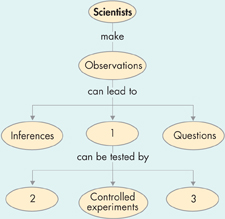1 Study Guide
 Science as a Way of Knowing
Science as a Way of Knowing
By applying scientific methodology, biologists can find answers to questions that arise in the study of life.
1.1 What Is Science?
 One goal of science is to provide natural explanations for events in the natural world. Science also aims to use those explanations to understand patterns in nature and to make useful predictions about natural events.
One goal of science is to provide natural explanations for events in the natural world. Science also aims to use those explanations to understand patterns in nature and to make useful predictions about natural events.
 Scientific methodology involves observing and asking questions, making inferences and forming hypotheses, conducting controlled experiments, collecting and analyzing data, and drawing conclusions.
Scientific methodology involves observing and asking questions, making inferences and forming hypotheses, conducting controlled experiments, collecting and analyzing data, and drawing conclusions.
1.2 Science in Context
 Curiosity, skepticism, open-mindedness, and creativity help scientists generate new ideas.
Curiosity, skepticism, open-mindedness, and creativity help scientists generate new ideas.
 Publishing peer-reviewed articles in scientific journals allows researchers to share ideas and to test and evaluate each other's work.
Publishing peer-reviewed articles in scientific journals allows researchers to share ideas and to test and evaluate each other's work.
 In science, the word theory applies to a well-tested explanation that unifies a broad range of observations and hypotheses and that enables scientists to make accurate predictions about new situations.
In science, the word theory applies to a well-tested explanation that unifies a broad range of observations and hypotheses and that enables scientists to make accurate predictions about new situations.
 Using science involves understanding its context in society and its limitations.
Using science involves understanding its context in society and its limitations.
1.3 Studying Life
 Living things are made up of units called cells, are based on a universal genetic code, obtain and use materials and energy, grow and develop, reproduce, respond to their environment, maintain a stable internal environment, and change over time.
Living things are made up of units called cells, are based on a universal genetic code, obtain and use materials and energy, grow and develop, reproduce, respond to their environment, maintain a stable internal environment, and change over time.
 The study of biology revolves around several interlocking big ideas: the cellular basis of life; information and heredity; matter and energy; growth, development, and reproduction; homeostasis; evolution; structure and function; unity and diversity of life; interdependence in nature; and science as a way of knowing.
The study of biology revolves around several interlocking big ideas: the cellular basis of life; information and heredity; matter and energy; growth, development, and reproduction; homeostasis; evolution; structure and function; unity and diversity of life; interdependence in nature; and science as a way of knowing.
 Biology includes many overlapping fields that use different tools to study life from the level of molecules to the entire planet.
Biology includes many overlapping fields that use different tools to study life from the level of molecules to the entire planet.
 Most scientists use the metric system when collecting data and performing experiments.
Most scientists use the metric system when collecting data and performing experiments.
biology (17)
asexual reproduction (19)
DNA (18)
homeostasis (19)
stimulus (18)
metabolism (19)
sexual reproduction (19)
biosphere (21)
Think Visually Using the information in this chapter, complete the following concept map:

Table of Contents
- Formulas and Equations
- Applying Formulas and Equations
- Mean, Median, and Mode
- Estimation
- Using Measurements in Calculations
- Effects of Measurement Errors
- Accuracy
- Precision
- Comparing Accuracy and Precision
- Significant Figures
- Calculating With Significant Figures
- Scientific Notation
- Calculating With Scientific Notation
- Dimensional Analysis
- Applying Dimensional Analysis





